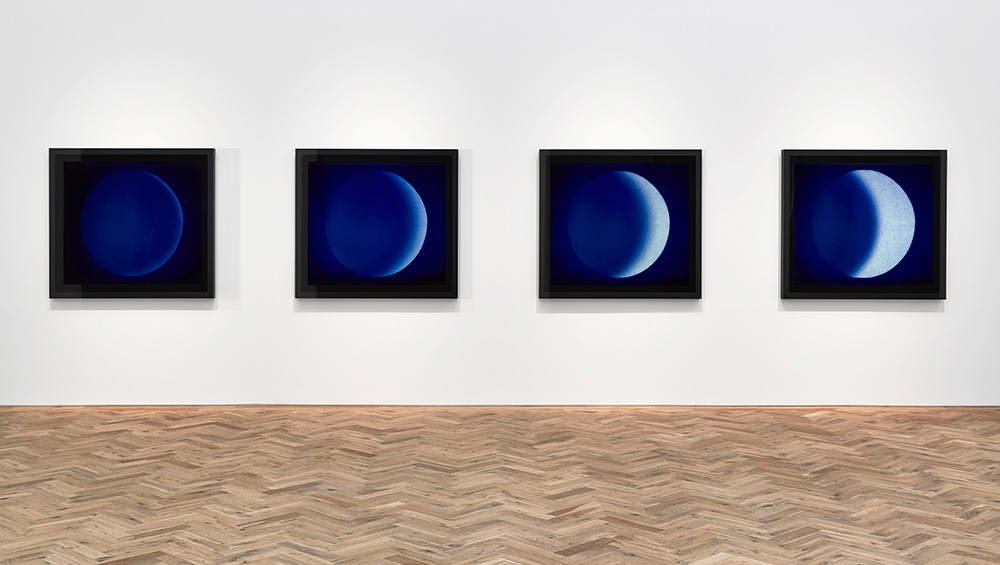
Garry Fabian Miller: Midwinter Blaze, installation view, Ingleby, Edinburgh (October - December 2019). Photo: John McKenzie. Courtesy of the Artist and Ingleby, Edinburgh.
Ingleby Gallery, Edinburgh
12 October – 20 December 2019
by CHRISTIANA SPENS
With its longstanding history of photographic invention and innovation, Edinburgh is a fitting host for Garry Fabian Miller’s latest exhibition. Working without a camera, but using a darkroom and the early-19th century techniques first developed in this city, he has explored the possibilities of light as a subject as well as a medium for the past 35 years. What emerges in Midwinter Blaze is a moving and sensual meditation on time and our exposure to it; a chance to stand in measured moments arranged by one whose eyes have been trained to its subtleties and structures.

Garry Fabian Miller. Midwinter Blaze I,II,III, IV, 2019. Light, water, Lightjet c-type print from unique dye destruction print, 122.5 x 139.4 cm (framed each part). Courtesy of the Artist and Ingleby, Edinburgh.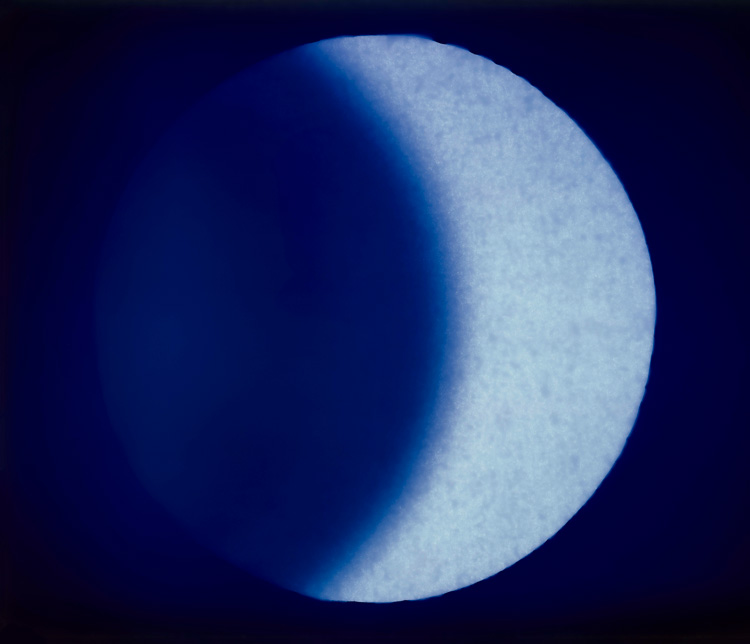
Garry Fabian Miller. Midwinter Blaze IV, 2019. Light, water, Lightjet c-type print from unique dye destruction print, 122.5 x 139.4 cm (framed). Courtesy of the Artist and Ingleby, Edinburgh.
Passing light through coloured glass and liquid, on to photographic paper, using long exposures lasting up to 20 hours, Miller creates individual, glowing images. Entering the gallery, the first suite of prints shows the phases of the moon, from a barely visible new moon – a mere shadow of indigo against a black sky – to a hint of a crescent, then a prominent one and then a luminous quarter moon. The images are hypnotising in their opaque impressions, seemingly fleeting and delicate despite being captured here, in large framed prints. Because the prints are in glass frames, they reflect the other pictures hanging in the room, leading to an interesting disruption: a pyramid-like image resembling a lit Christmas tree emerges ghost-like in the background, as well as visitors to the exhibition. Time, though measured and captured scientifically, is chaotically challenged and distracted from with other images and other times, creating an interesting, possibly accidental, sense of subversion.
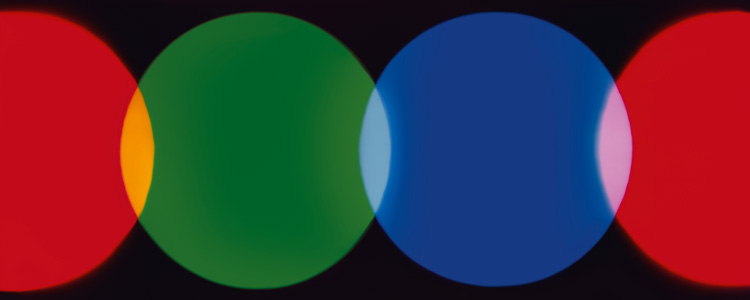
Garry Fabian Miller. A Lost Colour World, 2019. Light, water, Lambda c-type print from unique dye destruction print, 123 x 275.4 x 7.6 cm (framed). Courtesy of the Artist and Ingleby, Edinburgh.
On another wall, there are more spheres of light: this time, they are more richly coloured, with four circles overlapping in red, green and blue, against a dark background. A heavy black frame gives a sense of looking through a camera lens or microscope, seeing colours multiply or unfold. Where the colours overlap, there are areas of brighter light, creating a tension and pulling the viewer into these triple focal points. Again, the image magnetises, draws energy into these spaces as if our gaze is light drawn to this exposure.
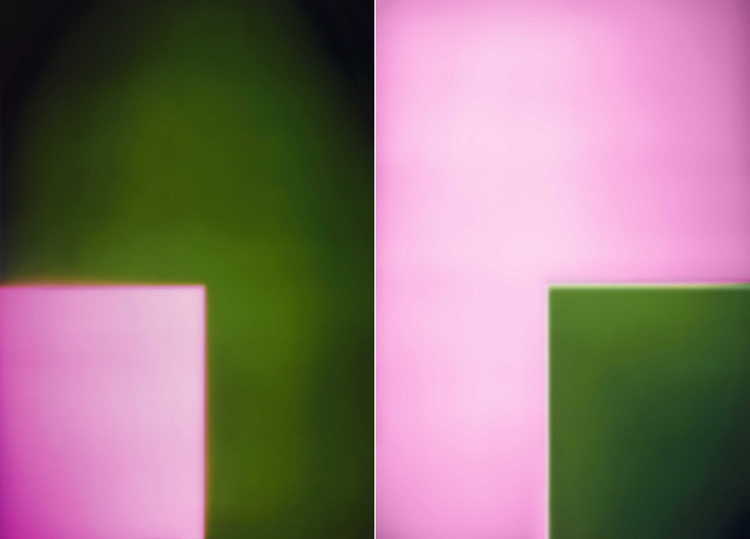
Garry Fabian Miller. Memories lived in this place, 2019. Light, water, Lambda C-print from dye destruction print, 146.4 x 195.6 cm (framed). Courtesy of the Artist and Ingleby, Edinburgh.
Further along, there is an interesting green-and-pink image: two rectangles, one in each colour, with a smaller rectangle in each corner, of the alternate colour. The depth of colour is uneven, creating puddles of light and dark, and a sense of spreading volume and luminosity that conflicts with the harsh geometry of the pattern within the image. Light gathers at the edges of the rectangles, again casting doubt as to the integrity of the shapes and structures first apparent. Light and shape push against each other, creating a compelling movement.
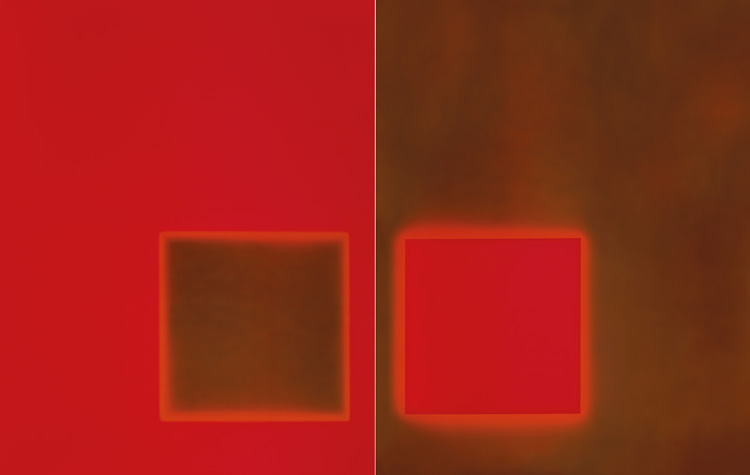
Garry Fabian Miller. Joy and Gravitation, 2016. Light, water, Lambda C-print from dye destruction print (two parts), 148.3 x 221.3 cm (framed). Courtesy of the Artist and Ingleby, Edinburgh.
In another similar work, this time two squares against two rectangles, in crimson and a warm brown, the edges of the shapes are bleached with light, where the red seems to burn against the paper. Reminiscent of Mark Rothko’s famous abstract paintings, this image also mesmerises and haunts; it is difficult to leave its pull.
In another image, a golden yellow circle against a light brown background, which is darker in its centre, similarly draws me in; the cheerfulness of the colours betrays an almost sinister impression of a whirlpool or black hole.
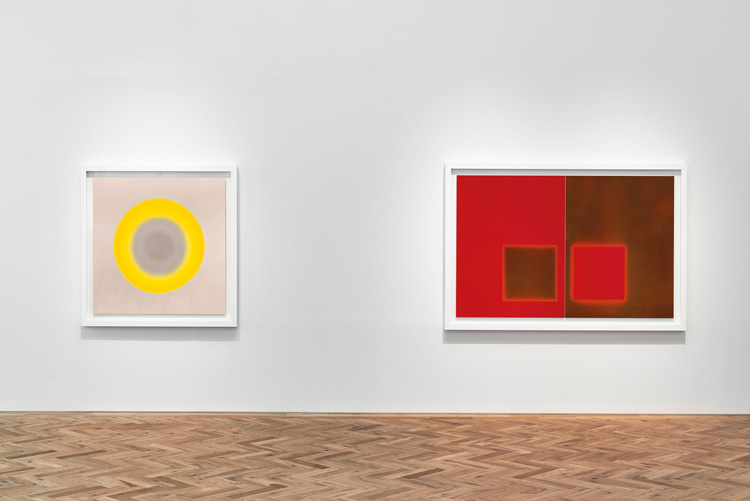
Garry Fabian Miller: Midwinter Blaze, installation view, Ingleby, Edinburgh (October - December 2019). Photo: John McKenzie. Courtesy of the Artist and Ingleby, Edinburgh.
Experiencing each of these works, there is a growing feeling of being in some out-of-body space, in which our consciousness becomes an energy similar to light itself. We move around, drawn into spaces, most exposed, most powerful, settling in the spaces of these images in which the colour is almost bleached out. Or perhaps, on another sort of day, where the light has been repelled and pushed away, and shadows dwell in indigo and black inkiness instead.
It is interesting to move into these spaces, to merge with art so unconsciously. Stripping down his practice to these experiments in physics and the strange crossover with human emotion or perception, Miller has understandably built a reputation as a progressive and compelling artist working within the realm of photography. Using the darkroom alone, he creates a fascinating alchemy with which to experiment not only with the medium itself, but with how we, as viewers, melt into the objects of our gaze.
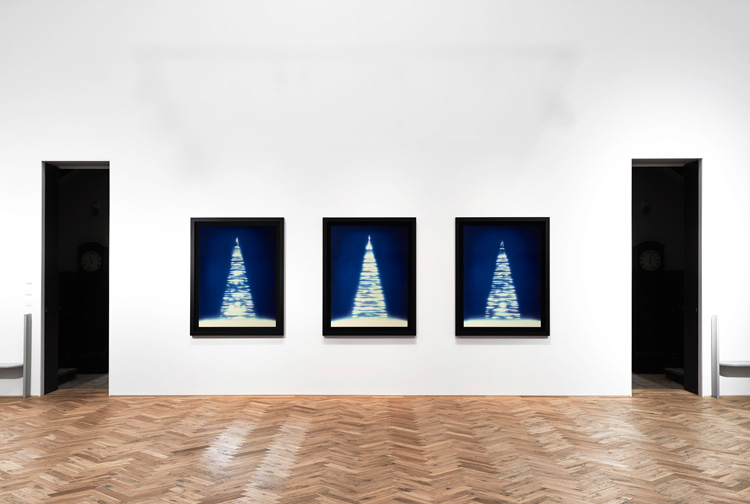
Garry Fabian Miller: Midwinter Blaze, installation view, Ingleby, Edinburgh (October - December 2019). Photo: John McKenzie. Courtesy of the Artist and Ingleby, Edinburgh.
As the materials with which Miller has developed his techniques and experimented with these ideas begin to run out, these works perhaps gain greater significance, imbued with a further sense of their fleetingness. As digital photography gradually pushes some analogue techniques and materials to extinction, Miller embraces the uniqueness of his practice. His works here are testament to the fact that this tension between structure and light, or form and ingenuity, is a space in which to blaze and burn, just as it is a reminder of the chaos and confusion underlying every pattern and design.
• A new book, titled Blaze, with an introduction by artist and writer Edmund de Waal, is published by Ingleby to accompany the exhibition.